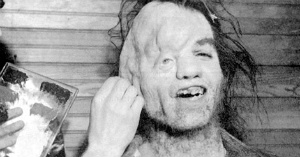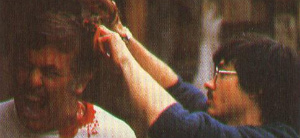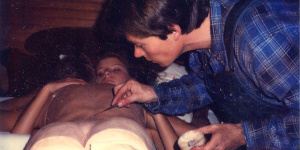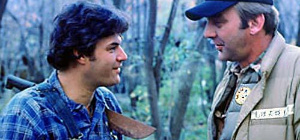
Director: Steve Miner
Writer: Ron Kurz
Starring: Adrienne King, Amy Steel, John Furey, Kirsten Baker, Stu Charno, Marta Kober
Rating: R (USA), 18 (UK), R (Australia)
With Friday the 13th clearing up at the box office and attracting major, albeit negative, attention from the press, just days after its release there was serious consideration for a sequel. Both Paramount and Georgetown, who had financed the film independently before selling it on for a huge profit, had not expected such a reaction from horror fans and knew that there was still money to be made. With Warner Bros. having secured the international rights to the movie, Mancuso Sr. was determined for Paramount to own the worldwide copyrights to the second film, whilst Georgetown pushed for the sequel to enter production as early as possible. Paramount had agreed to this but on the condition that Georgetown put up the money themselves and if they delivered a product that was as marketable as the original then Paramount would distribute it as a negative pick-up. Almost every studio in town had begun to emulate the formula of Friday the 13th (just like it had done itself with Halloween) and soon the market was becoming saturated with inferior clones that would turn effective plot-points into genre clichés. But which direction would the sequel take as almost all of the principal characters had been so successfully killed off at the end of the first movie?
The first blow came when Sean. S Cunningham, Victor Miller and Tom Savini all declined the chance to return, on grounds that a sequel was illogical and dumb. Miller had never envisioned a further instalment when he developed the story and Cunningham had no intentions of making the same film again. Savini, however, was the most out-spoken regarding the stupidity of a sequel and instead opted to work on another summer camp slasher, The Burning. With all of the key participants clearly unavailable, Georgetown were forced to search elsewhere for talent that could keep the project alive. Phil Scuderi had already drafted in former theatre manager-turned-screenwriter Ron Kurz to doctor Miller’s script for the first film and so he was the obvious choice when it came to developing a sequel. Kurz had been omitted from the credits for Friday the 13th due to irregularities with the Writers Guild and had decided to amend the errors so that he would receive full credit for the second script. There first major obstacle was which direction should the new story take? After all, Mrs. Voorhees, the vengeful killer who was still mourning the death of her son, had been decapitated at the end of Miller’s script so it was impossible for her return, unless the sequel was to take a supernatural turn. Scuderi was adamant from the very beginning that the focus should shift to the son, Jason, and that somehow he should have survived the drowning all those years ago and somehow remained out of sight from the townspeople (and Mrs. Voorhees it would seem) for over twenty years. It was this illogical suggestion that alienated Cunningham and his collaborators. But not all were so sceptical about bring back Jason.

Steve Miner, who had been a major driving force in the production of Friday the 13th, from storyboarding elaborate effect scenes to directing the second unit (most notably during the hospital scene that had closed the first film), and so Georgetown offered Miner the chance to finally make his directorial debut. Immediately, Miner set about trying to bring back crew members from the first film, including cinematographer Peter Stein (who had acted as DOP for the aforementioned hospital scene), editor Susan Cunningham and production designer Virginia Field. Miner also attempted to convince Savini but he had already begun work in New York on his next feature and so he contacted Stan Winston, his neighbour from his time in Los Angeles who had been a struggling stand up comedian whilst developing an interest in special effects. Unfortunately, Winston was also preoccupied but sculpted a head mould of Betsy Palmer who would cameo as Mrs. Voorhees’ severed head. Respected makeup artist Dick Smith suggested an up-and-coming talent called whose impressive work on Friday the 13th Part 2 would sadly be almost non-existent after the MPAA butchered the movie. Carl Fullerton first entered the industry in the mid 1970’s after applying for an apprenticeship with NBC-TV in New York, primarily due to his idol, Smith, once being the head of makeup there. During his time at the network, he worked on the likes of Saturday Night Live before making his feature debut on the low budget horror The Rituals, which starred The Fog’s Hal Holbrook. His next project was the Michael Jackson/Diana Ross vehicle The Wiz, a black adaptation of The Wizard of Oz, before finally collaborating with Smith on Ken Russell’s 1980 cult classic Altered States.
One young face to appear among the crew was a man who would later become a major driving force within the franchise and who, after taking his first steps into the industry as a teenager working as a booker for Paramount, liaising with theatres in Canada, would eventually rise to become one of the most successful producers of the eighties. Frank Mancuso Jr. was the son of the then-head of Paramount, who had taken a gamble with Friday the 13th the previous year and turned it into a blockbuster. Initially brought on set to keep an eye on the studio’s investment, Mancuso would assist the filmmakers in every aspect of production, earning himself an ‘associate producer’ credit and a reputation as a shrewd businessman. With a trustworthy crew in place, Miner then had to find a suitable cast to play his machete fodder and, more importantly, a stuntman who could portray his faceless antagonist. With Alice, the first film’s headstrong heroine, a hit with the fans, Minasian and Scuderi immediately began negotiations with Adrienne King’s agent to bring the actress back for the sequel. Unfortunately, neither party were able to agree on a fee as the agent had demanded a higher salary for their client and so the producers were forced to ask Kurz to kill the character off after the opening scene. This meant that they needed a new heroine and so Ginny Field, named after the production designer, was created. Eventually, the producers settled on Amy Steel, a twenty-year old former model-turned-actress from West Chester, Pennsylvania who had previously had recurring roles in such television shows as Guiding Light and All My Children. Her co-stars would include several young faces who had already appeared in horror films, such as He Knows You’re Alone’s Russell Todd and Dressed to Kill’s Bill Randolph.

For the role of Jason, one of the most important aspects of the production, Miner approached Taso Stavrakis, who had portrayed the killer for the majority of the first film, though the stuntman declined, later admitting it to be one of the worst decisions of his career. Warrington Gillette, who was just five months older than Steel, had initially auditioned for the role of Paul Holt, Ginny’s boyfriend and the male lead. With the producers eventually settling on John Furey, a TV actor who had appeared in the likes of ChiPs, Logans Run and The Waltons, Gillette was offered the part of Jason after claiming to have minor stunt experience. After excessive prosthetic application, which involved at least six hours in makeup and a pair of fake dentures, Gillette’s first day of filming was to be for a scene towards the end of the movie where an unmasked Jason jumped through a window. When it became clear to both Miner and stun coordinator Cliff Cudney that their actor was incapable of performing the stunts that were required for the role, he left the production and the filmmakers suddenly found themselves without a villain. At a loss, Cudney suggested a friend of his who had quit the NYPD to pursue a career as a stuntman and actor. Steve Daskawisz had ironically made his feature debut playing a cop in Neil Diamond’s 1980 hit The Jazz Singer before making the acquaintance of Cudney during the filming of Sylvester Stallone’s Nighthawks soon after. Out of work due to the actor’s strike (though Friday the 13th Part 2 had been given permission to continue), Daskawisz was broke and desperate for another role, borrowing $25 off his brother for gas and making his way down to the shoot in Kent, Connecticut the following day.
Prior to Daskawisz’s involvement, principal photography had commenced and Jason’s first appearance during the fourteen minute opening sequence would see two crew members filling in for the role. The film opens with a child splashing in rain puddles, only for Jason’s feet to appear moments later. This specific shot saw costume designer Ellen Lutter playing the part, before being replaced by production assistant Jerry Wallace for the scene in which Jason stabs Alice in the head with an ice pick. This relatively bloodless prologue would show off Winston’s handiwork with the head of Mrs. Voorhees seen in Alice’s fridge. Despite the lack of gore shown throughout the movie, there were several elaborate and graphic set pieces shot for Friday the 13th Part 2, courtesy of Fullerton and his crew. The death of Todd’s character, Scott, was to an excessive bloodspill that was reduced to mere suggestion for the version that was released. For the effect, which saw Scott strung upside down from a branch before having his throat slit, makeup assistant John Caglione Jr. (who had made several student films with Todd in high school) had cast his neck and created a foam appliance in which a deep cut was carved in which blood would later run from to simulate a knife wound. A tube was attached to the actor’s leg and ran up into the tree above where another effects artist would operate a pump that would send the blood down to the wound. Unfortunately, at least for the actor, far more blood than expected was pumped out and made its way into Todd’s eyes, forcing him to have to remain in character until Miner had completed filming.

For perhaps the most impressive effect of the movie, in which wheelchair-bound Mark (the late Tom McBride) receives a machete to the face before falling backwards down a set of steep steps, Fullerton modified a catcher’s mask to place over the actor’s head and then played the footage of the machete, constructed from balsa wood, in reverse to give the illusion of the blade striking his face. For the shot of Mark falling backwards, stuntman Tony Farentino (who had worked alongside both Fullerton and Calgione Jr. on Nighthawks) performed the dangerous stunt with the help of a special rig which had been designed to help avoid the wheelchair from losing control. One criticism levelled at the movie was that it had almost plagiarised a scene from Mario Bava’s notorious Reazione a catena (Twitch of the Death Nerve), in which a young couple are impaled during sex. Another impressive effect, this was achieved by the actress (Marta Kober in the role of Sandra) lying on her back with her shoulders against a couch support with Randolph lying on top of her. Dick Smith’s son, David, operated a pressure tank that was fixed to release the blood (made from jelly) on demand. An appliance was designed to attach to the actor’s back to double as his body (with skin created from gelatin), for which the pitchfork would be driven through.
During the shoot, Daskawisz would receive several injuries that would see him rushed off to the emergency room. The first time was during a scene where Jason is chasing Ginny through the woods, where the killer would jump out from behind a tree. The actor was supposed to hit a mark which had been dug out in a clearing but during one take, he landed with his pitchfork underneath his chest, cracking four of his ribs. Perhaps the most known of these accidents was during the climax when Ginny confuses Jason by wearing his mother’s jumper and pretending to be her. As Jason kneels down, Ginny raises a machete above her head and brings it down, only for Jason to realise just in time and knock the weapon to the ground with his axe. At one point, the blade of the machete struck Daskawisz’s hand and almost resulted in him losing a finger. Thankfully, thirteen stitches later he was back in front of the camera. Despite this, the producers were forced to bring Gillette back to shoot the scene where Jason is unmasked as the makeup appliance was designed to fit his face and body. This decision meant that Gillette would receive screen credit as Jason, even though he would only appear in one scene, while Daskawisz would be reduced to a mere stunt double credit.
Once the film was complete, it was submitted to the MPAA who, still embarrassed by allowing the first film to pass uncut, forced severe cuts on the filmmakers, which resulted in the final edit being rather neutered with regards to gore. In fact, it has often been considered by fans that the makers of Friday the 13th Part 2 intentionally filmed a bloodless sequel, though nothing could be further from the truth. If the footage still exists, as over time film can deteriorate, especially if it is not preserved well, then maybe one day Paramount will release an uncut version of the movie, though with their track record of so-called ’special editions’ this is highly doubtful. After all, it was only last month that they finally released Friday the 13th uncut, despite it being released in that form in the UK by Warner Bros. as early as 2003. 1981 saw countless slashers released, including The Prowler, My Bloody Valentine and Halloween 2, and Friday the 13th Part 2’s seemingly tame approach meant that many fans were unsatisfied with the result, despite an impressive box office performance. The producers knew that if the series was to continue they would need to find a new gimmick, something to make it stand out among its contemporaries. Finally, it was decided that Jason would have to go 3D.


2 Responses to CRYSTAL LAKE’S BLOODY LEGACY pt.2 – Friday the 13th Part 2 (1981)